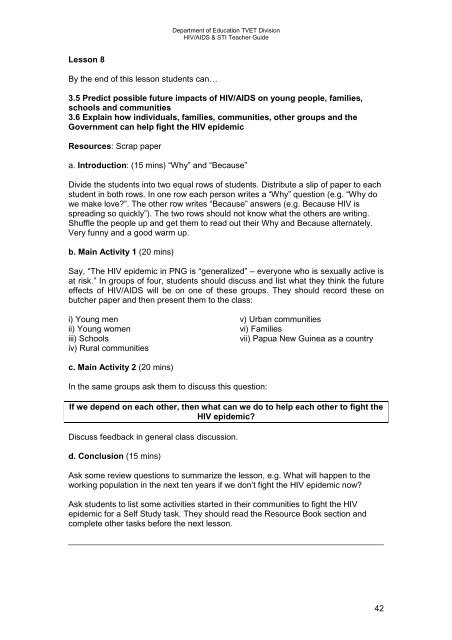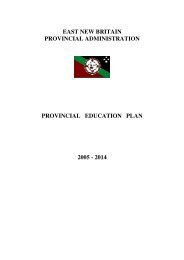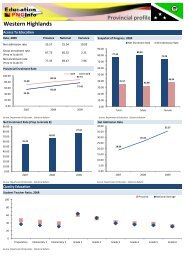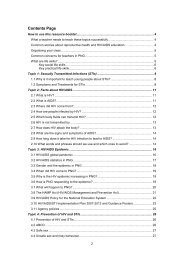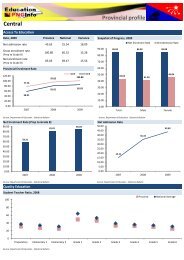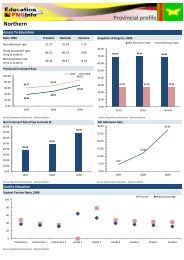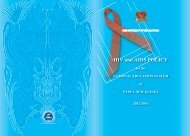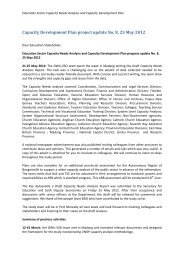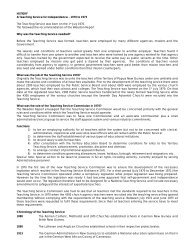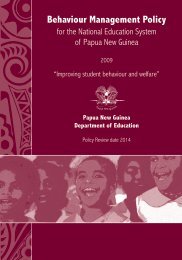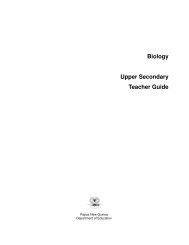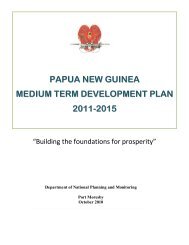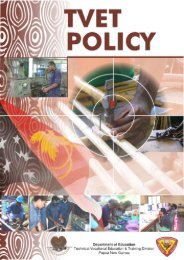Health Education to Prevent HIV/AIDS & STIs - Department of ...
Health Education to Prevent HIV/AIDS & STIs - Department of ...
Health Education to Prevent HIV/AIDS & STIs - Department of ...
You also want an ePaper? Increase the reach of your titles
YUMPU automatically turns print PDFs into web optimized ePapers that Google loves.
<strong>Department</strong> <strong>of</strong> <strong>Education</strong> TVET Division<br />
<strong>HIV</strong>/<strong>AIDS</strong> & STI Teacher Guide<br />
Lesson 8<br />
By the end <strong>of</strong> this lesson students can…<br />
3.5 Predict possible future impacts <strong>of</strong> <strong>HIV</strong>/<strong>AIDS</strong> on young people, families,<br />
schools and communities<br />
3.6 Explain how individuals, families, communities, other groups and the<br />
Government can help fight the <strong>HIV</strong> epidemic<br />
Resources: Scrap paper<br />
a. Introduction: (15 mins) “Why” and “Because”<br />
Divide the students in<strong>to</strong> two equal rows <strong>of</strong> students. Distribute a slip <strong>of</strong> paper <strong>to</strong> each<br />
student in both rows. In one row each person writes a “Why” question (e.g. “Why do<br />
we make love”. The other row writes “Because” answers (e.g. Because <strong>HIV</strong> is<br />
spreading so quickly”). The two rows should not know what the others are writing.<br />
Shuffle the people up and get them <strong>to</strong> read out their Why and Because alternately.<br />
Very funny and a good warm up.<br />
b. Main Activity 1 (20 mins)<br />
Say, “The <strong>HIV</strong> epidemic in PNG is “generalized” – everyone who is sexually active is<br />
at risk.” In groups <strong>of</strong> four, students should discuss and list what they think the future<br />
effects <strong>of</strong> <strong>HIV</strong>/<strong>AIDS</strong> will be on one <strong>of</strong> these groups. They should record these on<br />
butcher paper and then present them <strong>to</strong> the class:<br />
i) Young men<br />
ii) Young women<br />
iii) Schools<br />
iv) Rural communities<br />
v) Urban communities<br />
vi) Families<br />
vii) Papua New Guinea as a country<br />
c. Main Activity 2 (20 mins)<br />
In the same groups ask them <strong>to</strong> discuss this question:<br />
If we depend on each other, then what can we do <strong>to</strong> help each other <strong>to</strong> fight the<br />
<strong>HIV</strong> epidemic<br />
Discuss feedback in general class discussion.<br />
d. Conclusion (15 mins)<br />
Ask some review questions <strong>to</strong> summarize the lesson, e.g. What will happen <strong>to</strong> the<br />
working population in the next ten years if we don’t fight the <strong>HIV</strong> epidemic now<br />
Ask students <strong>to</strong> list some activities started in their communities <strong>to</strong> fight the <strong>HIV</strong><br />
epidemic for a Self Study task. They should read the Resource Book section and<br />
complete other tasks before the next lesson.<br />
42


